胡壮麟语言学教程课件Part8
- 格式:pdf
- 大小:284.99 KB
- 文档页数:16


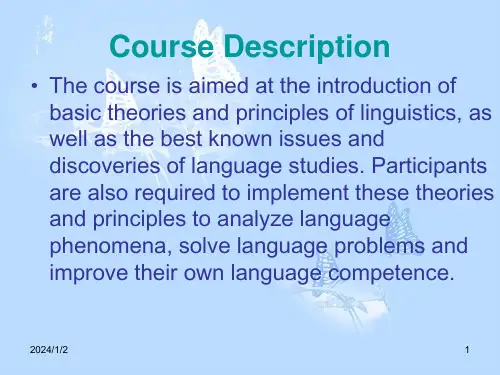
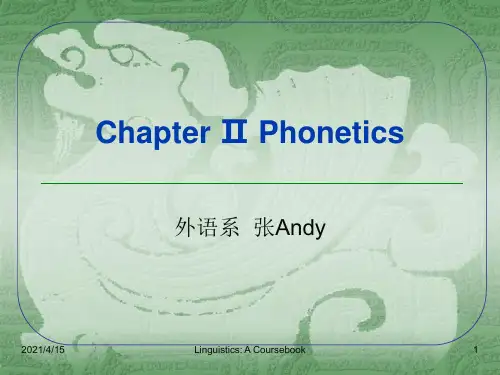

胡壮麟《语言学教程》笔记第8-9章Chapter 8 Language in Use1. 语义学与语用学的区别1.1 语用学(Pragmatics)Pragmatics is the study of the use of language in communication, particularly the relationships between sentences and the contexts and situations in which they are used.(语用学是研究语言实际运用的学科,集中研究说话人意义、话语意义或语境意义。
)1.2 区别Pragmatics is sometimes contrasted with semantics, which deals with meaning without reference to the users and communicative functions of sentences.(语用学主要研究在特定的语境中说话人所想要表达的意义,语义学研究的句子的字面意义,通常不考虑语境。
)2. 合作原则及其准则(Herbert Paul Grice)2.1. 合作原则(Cooperative Principle)说话人经常在话语中传达着比话语表层更多的信息,听话人也能够明白说话人所要表达的意思。
格莱斯认为一定存在一些管理这些话语产生和理解的机制。
他把这种机制称作合作原则。
2.2. 准则(maxims)数量准则(quantity)①使你的话语如(交谈的当前目的)所要求的那样信息充分。
②不要使你的话语比要求的信息更充分。
质量准则(quality)设法使你的话语真实①不要讲明知是虚假的话②不要说没证据的话关系准则(relation)所谈内容要密切相关方式准则(manner)要清晰。
①避免含糊不清②避免歧义③要简练(避免冗长)④要有序3. 言语行为理论(Speech Act Theory)---John Austin3.1. 施为句&叙事句(Performatives & Constatives)施为句是用来做事的,既不陈述事实,也不描述情况,且不能验证真假;叙事句要么用于陈述,要么用于验证,可以验证真假。
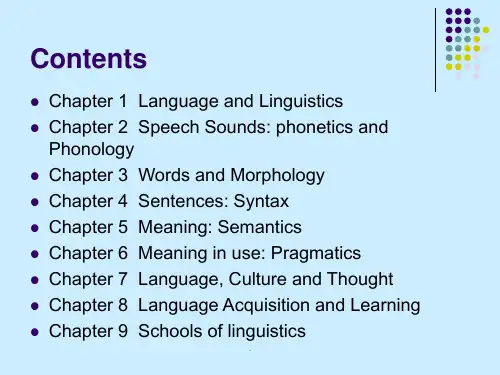
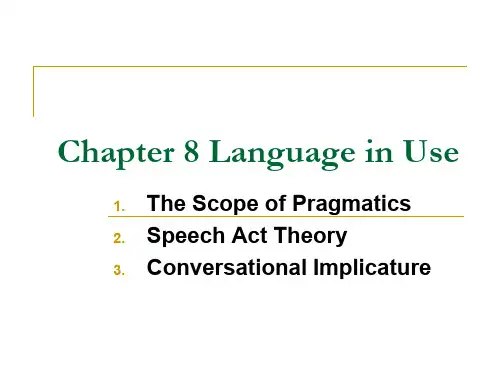
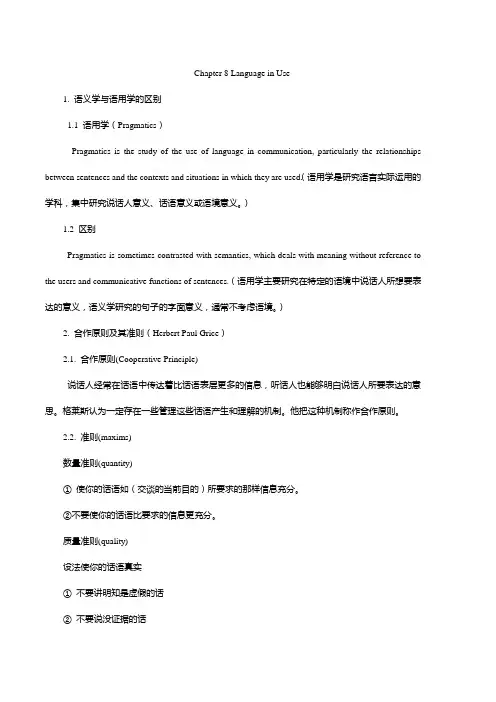
Chapter 8 Language in Use1. 语义学与语用学的区别1.1 语用学(Pragmatics)Pragmatics is the study of the use of language in communication, particularly the relationships between sentences and the contexts and situations in which they are used.(语用学是研究语言实际运用的学科,集中研究说话人意义、话语意义或语境意义。
)1.2 区别Pragmatics is sometimes contrasted with semantics, which deals with meaning without reference to the users and communicative functions of sentences.(语用学主要研究在特定的语境中说话人所想要表达的意义,语义学研究的句子的字面意义,通常不考虑语境。
)2. 合作原则及其准则(Herbert Paul Grice)2.1. 合作原则(Cooperative Principle)说话人经常在话语中传达着比话语表层更多的信息,听话人也能够明白说话人所要表达的意思。
格莱斯认为一定存在一些管理这些话语产生和理解的机制。
他把这种机制称作合作原则。
2.2. 准则(maxims)数量准则(quantity)①使你的话语如(交谈的当前目的)所要求的那样信息充分。
②不要使你的话语比要求的信息更充分。
质量准则(quality)设法使你的话语真实①不要讲明知是虚假的话②不要说没证据的话关系准则(relation)所谈内容要密切相关方式准则(manner)要清晰。
①避免含糊不清②避免歧义③要简练(避免冗长)④要有序3. 言语行为理论(Speech Act Theory)---John Austin3.1. 施为句&叙事句(Performatives & Constatives)施为句是用来做事的,既不陈述事实,也不描述情况,且不能验证真假;叙事句要么用于陈述,要么用于验证,可以验证真假。
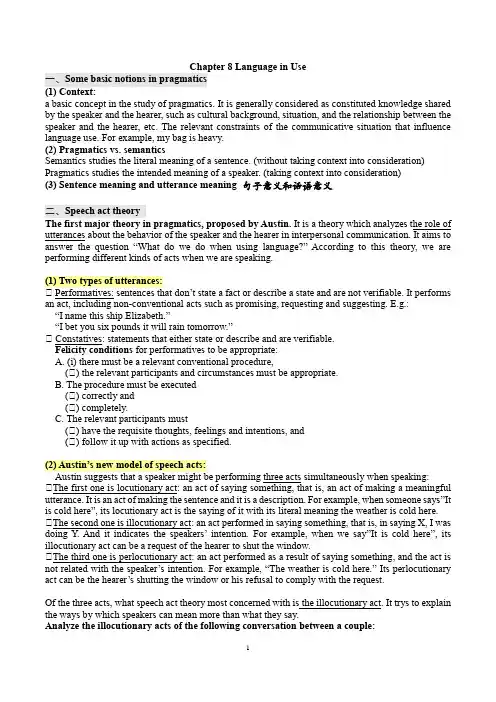
Chapter 8 Language in Use一、Some basic notions in pragmatics(1) Context:a basic concept in the study of pragmatics. It is generally considered as constituted knowledge shared by the speaker and the hearer, such as cultural background, situation, and the relationship between the speaker and the hearer, etc. The relevant constraints of the communicative situation that influence language use. For example, my bag is heavy.(2) Pragmatics vs. semanticsSemantics studies the literal meaning of a sentence. (without taking context into consideration) Pragmatics studies the intended meaning of a speaker. (taking context into consideration)(3) Sentence meaning and utterance meaning 句子意义和话语意义二、Speech act theoryThe first major theory in pragmatics, proposed by Austin. It is a theory which analyzes the role of utterances about the behavior of the speaker and the hearer in interpersonal communication. It aims to answer the question “What do we do when using language?” According to this theory, we are performing different kinds of acts when we are speaking.(1) Two types of utterances:① Performatives: sentences that don’t state a fact or describe a state and are not verifiable. It performs an act, including non-conventional acts such as promising, requesting and suggesting. E.g.:“I name this ship Elizabeth.”“I bet you six pounds it will rain tomorrow.”① Constatives: statements that either state or describe and are verifiable.Felicity conditions for performatives to be appropriate:A. (i) there must be a relevant conventional procedure,(①) the relevant participants and circumstances must be appropriate.B. The procedure must be executed(①) correctly and(①) completely.C. The relevant participants must(①) have the requisite thoughts, feelings and intentions, and(①) follow it up with actions as specified.(2) Austin’s new model of speech acts:Austin suggests that a speaker might be performing three acts simultaneously when speaking:①The first one is locutionary act: an act of saying something, that is, an act of making a meaningful utterance. It is an act of making the sentence and it is a description. For example, when someone says”It is cold here”, its locutionary act is the saying of it with its literal meaning the weather is cold here.①The second one is illocutionary act: an act performed in saying something, that is, in saying X, I was doing Y. And it indicates the speakers’ intention. For example, when we say”It is cold here”, its illocutionary act can be a request of the hearer to shut the window.①The third one is perlocutionary act: an act performed as a result of saying something, and the act is not related with the speaker’s intention. For example, “The weather is cold here.” Its perlocutionary act can be the hearer’s shutting the window or his refusal to comply with the request.Of the three acts, what speech act theory most concerned with is the illocutionary act. It trys to explain the ways by which speakers can mean more than what they say.Analyze the illocutionary acts of the following conversation between a couple:——— (the telephone rings)——— H: That’ the phone. (1)——— W: I’ m in the bathroom. (2)——— H: Okay. (3)This seemingly incoherent conversation goes on successfully because the speakers understand each other’s illocutionary acts:1) Asking his wife to go and answer the phone.2) A refusal to comply with the request; asking her husband to answer the phone instead.3) Accepting the wife’s refusal and accepting her request, meaning “all right, I’ll answer it.”(3) Searle’s classification of illocutionary acts:Searle has made great contribution to the development of the speech act theory. According to Searle, speech act are divided into five general categories. That is, five general types of things we do with language. Each type has a common, general purpose. They are representatives, directives, commsives, expressives, declarations. (阐述类、指令类、承诺类、表达类、宣告类)三、The theory of conversational implicature 会话含义理论The second major theory in pragmatics. Proposed by Grice.In daily communication, people are observing a set of basic rules of cooperating with each other so as to communicate effectively through conversation. He calls this set of rules the cooperative principle elaborated in four maxims.(1) Cooperative principle (CP)In making a conversation, all participants are expected to observe a general principle: Make your conversational contribution such as is required, at the stage at which it occurs, by the accepted purpose or direction of the talk exchange in which you are engaged.Four maxims of CP:1) The maxim of quantity1) Make your contribution as informative as is required (for the current purposes of the exchange).2) Do not make your contribution more informative than is required.2) The maxim of qualityTry to make your contribution one that is true.1) Do not say what you believe to be false.2) Do not say that for which you lack adequate evidence.3) The maxim of relationBe relevant.4) The maxim of mannerBe perspicuous.1) Avoid obscurity of expression.2) Avoid ambiguity.3) Be brief.4) Be orderly.(2) Conversational implicatureAccording to Grice, it refers to the extra meaning not contained in the utterance, but understandable to the listener. Only when he shares the speakers’ knowledge or he knows why and how, he violates intentionally one of the four maxims of CP.The following provides different circumstances of the violation of CP and its maxims.1) Violation of the maxim of quantityA:When is Lucy’s birthday party?B:Sometimes next month.A:Where is X?B:He’s gone to the library. He said so when he left.2) Violation of the Maxim of qualityHe is made of iron. (Metaphor)Every nice girl loves a sailor.3) Violation of the maxim of relationA: How do you like my painting?B: I’m afraid I don’t have any eye for beauty. A: What time is it?B: The postman has just arrived.4) Violation of the maxim of mannerA: Shall we get something for the kids?B: Yes. But I veto I-C-E-C-R-E-A-M.A:Where is your mother?B: She is either in the room or at the market. (3) Characteristics of implicature(4) Politeness Principle (PP)Leech suggests that CP can’t explain why people are often so indirect in conveying what they mean. Conversational interaction is a social behaviour. Choice of linguistic codes is central in language use. There are social and psychological factors that determined the choice.Besides being cooperative, participants try to be polite. And the speakers consider the matter of face for themself and others. Based on this observation, Leech proposed PP, which contains six maxims.1.Tact 策略Minimize cost to other.Maximize benefit to other.2.Generosity 宽宏Minimize benefit to self.Maximize cost to self.3.Approbation 赞扬Minimize dispraise of other.Maximize praise of other.4.Modesty 谦虚Minimize praise of self.Maximize dispraise of self.5.Agreement 赞同Minimize disagreement between self and other.Maximize agreement between self and other.6.Sympathy 同情Minimize antipathy between self and other.Maximize sympathy between self and other.四、Post-Gricean Developments3.Levinson’s Q- , I- and M- principles。

2. What is this course about?Chapter 1 Invitations to LinguisticsChapter 2 Speech SoundsChapter 3 LexiconChapter 4 SyntaxChapter 5 MeaningChapter 6 Language and cognitionChapter 7 Language, Culture, and SocietyChapter 8 Language in useChapter 9 language and literatureChapter 10 language and computerChapter 11 linguistics and foreign language teachingChapter 12 Theories and schools of modern linguistics1. languageDefinitionFeaturesFunctions1) Definition:Sapir, 1921: Language is a purely human and non-instinctive method of communicating ideas, emotions and desires by means of voluntarily produced symbols.(语言是纯粹人为的、非本能的、用任意制造出来的符号系统来传达观念、情绪和欲望的方法。
)Hall, 1968: Language is "the institution whereby humans communicate and interact with each other by means of habitually used oral-auditory arbitrary symbols." (语言是人们通过惯用的任意性的口头-听觉符号进行交际和互动的惯例。
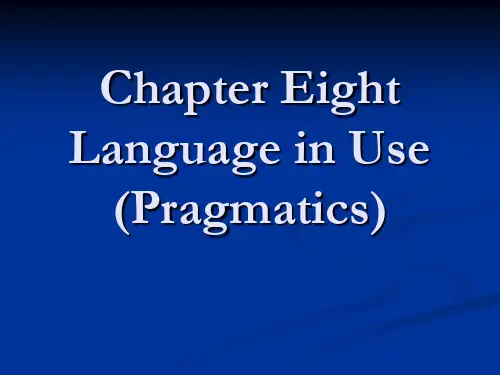
第8章语言的使用8.1 复习笔记本章要点:1. Speech act theory言语行为理论2. Cooperative principle and its maxims合作原则及其准则3. Gricean theory of conversational implicature格莱斯会话含义理论4. Politeness principle礼貌原则5. Post-Gricean developments后格莱斯时期的发展常考考点:语用学的定义;语义学与语用学的区别;语境与意义;言语行为理论(发话行为、行事行为和取效行为);合作原则。
实例分析言语行为、合作原则的违反和会话含义。
“话语意义”和“句子意义”的区别。
本章内容索引:I. Pragmatics1. Definition2. Difference between pragmatics and semantics II. Speech Act Theory1. Performatives and Constatives(1) Definition(2) Felicity Conditions2. A Theory of the Illocutionary Act3. Searle’s Classification of Speech Acts(1) Representatives:(2) Directives(3) Commsives(4) Expressives(5) DeclarationsIII. Cooperative Principle (CP)1. Cooperative Principle and Its Maxims2. Violation of the MaximsIV. Conversational Implicature1. Definition2. Characteristics of Conversational Implicature(1) Calculability.(2) Cancellability(3) Non-detachability(4) Non-conventionality.V. Politeness Principle (PP)VI. Post-Gricean Developments1. Relevance Theory2. The Q- and R-principles3. Levinson’s Q-, I-and M-principles▼4. A socio-cognitive approachI. Pragmatics (语用学)【考点:Pragmatics与Semantics的异同】1. Definition (定义)Pragmatics is the study of language in use, focusing on the study of speaker’s meaning, utterance meaning or contextual meaning.语用学是研究语言实际运用的学科,集中研究说话人意义、话语意义或语境意义。
Chapter 5 Meaning Semantics:the study of the meaning of linguistic units, words and sentences in particular.5.1 Meanings of “meaning”7 types of meaning(Leech):1. Conceptual meaning: Logical, cognitive, ordenotative contentAssociate meaning:2. Connotative meaning:What is communicatedby virtue of what language refers to.3. Social meaning:What is communicated of thesocial circumstances of language use.4. Affective meaning: What is communicated ofthe feelings and attitudes of thespeaker/writer.5. Reflected meaning: What is communicatedthrough association with another sense ofthe same expression.6. Collocative meaning: What is communicatedthrough association with words which tendto occur in the environment of another word.7.Thematic meaning: What is communicatedby the way in which the message isorganized in terms of order and emphasis.-Connotation and denotation5.2 The referential theory-The theory of meaning which relates the meaning of a word to the thing it refers to, or stands for, is known as the referential theory.-Semantic triangle(Ogden and Richards):conceptword thing-Sense and reference5.3 Sense relationsSense: the semantic relations between one word and another, or more generallybetween one linguistic unit and another.3 kinds of sense relations:1)Sameness relation---Synonymy2)Oppositeness relation---Antonymy3)Inclusiveness relation---Hyponymy5.3.1 Synonymy1)Differ in style: buy and purchase2) Differ in connotations: thrifty, economicaland stingy3) Dialectual difference: autumn and fall, flatand apartment, underground and tube5.3.2 Antonymy1) Gradable antonymy: good-bad, long-short, big-small, hot-cold, warm-cool“Marked”(unusual)and “Unmarked”(the cover term, unusual, e.g. old)2) Complementary antonymy:alive-dead, male-female,present-absent, pass-fail (a test),odd-even, hit-miss (a target), boy-girl3) Converse antonymy(Relational opposite): buy-sell, lend-borrow, give-receive, before-after, husband-wife, host-guest, employee-employer5.3.3 Hyponymy Hyponyms: the members, the lower termsCo-hyponyms: members of the same classSuperordinate:the name of a classA superordinate may be missing. Hyponyms may also be missing.Ex. livingplant animalbird fish insect animalhuman animaltiger lion elephant …5.4 Componential analysis Componential analysis refers to an approach by structural semantics in describing the meaning of words.It aims at breaking down the meaning of a word into its minimal distinctive features which are also called components.E.g. the meaning of the word boy may be analyzed into three components: HUMAN, YOUNG and MALE. Girl may be analyzed into HUMAN, YOUNG and FEMALE; man into HUMAN, ADULT and MALE, and woman into HUMAN, ADULT and FEMALE.5.5 Sentence meaning5.5.1 An integrated theoryThe principle of compositionality: the meaning of a sentence depends on the meanings of the constituent words and the way they are combined.A semantic theory consists of two parts(Katz and Postal): a grammantical classification and semantic rules.Grammatical/Syntactic markers Semantic markers DistinguishersSelection restrictions Problems5.5.2 Logical semantics Propositional logic( propositional calculus or sentential calculus) is the study of the truth conditions for propositions: how the truth of a composite proposition is determined by the truth value of its constituent propositions and the connections between them.“A proposition is what is expressed by a declarative sentence when that sentence is uttered to make a statement.”(J.Lyons)Predicate logic( predicate calculus) studies the internal structure of simple propositions.Argument and predicateAn argument is a term which refers to some entity about which a statement is being made.A predicate is a term which ascribes some property, or relation, to the entity, or entities, referred to. In terms of the number of arguments it takes, it can be classified into: one-place predicate: Socrates is a man.two-place predicate:John loves Mary.three-place predicate: John gave Mary a book.Questions and Exercises Some people maintain that there are no truesynonyms. If two words mean really the same, one of them will definitely die out. Do you agree? In general what type of meaning we are talking about when we say two words are synonymous with each other?Consider the following antonyms: friendly:unfriendly, honest: dishonest, normal: abnormal, logical: illogical.Which type of antonymy do they belong to?Comment on F.R.Palmer’s following argument: “…We can treat male/female, married/single, alive/dead as gradable antonyms on occasions. Someone can be very male or more married and certainly more dead than alive.”Which type of antonymy do the following antonyms belong to? Bigger:smaller, longer:shorter, better: worse, older: younger.姜望琪(1991:79)claims that “To some extent, we can say that any two words of the same part of speech may become antonyms, as long as the meaning difference between them is what needs to be emphasized in the particular context.”He uses the two sentences below as examples. What do you think of the claim?You have to peel a raw potato but you can skin a boiled one. He’s no statesman, but a mere politician.。
胡壮麟《语言学教程》(修订版)学习指导前言其实我的这一个语言学学习指导系列本来没有想做得这么大的,最初只是我买了一本语言学教程的辅导资料,发现里面有的名词解释总结得很不错,所以就想整理一下各章的名词解释。
后来觉得既然是整理,光整理名词解释,还不如对知识点做一个较全面的学习指导材料。
结果就此一发而不可收,终于形成了现在的这一整套资料。
不明白是什么的朋友们可以参考考研论坛外语版的相关帖子。
本资料主要分为三部分,第一部分为各章节提纲笔记,第二部分为重点章节测试题,第三部分为测试题参考答案。
整理这一套资料真得很劳心费力,希望能够对大家有所帮助。
在考研论坛上,我所有的相关资料都设置了阅读权限和K币,一个是为了防止盗用,但更重要的不是为了限制什么,只是希望大家在能够很容易得到资料的同时,也能够想到要付出一些,将来考上研了以后能够回到这里,与后来的研友们分享一些所能够得到的信息,资源共享,信息交流,这才是考研论坛的本意。
也希望大家在以后复习语言学的时候,能够想到冰暖茶在这门课程上作的小小的努力,如果大家都能成功,我的努力就是值得的。
需要说明的是,我在整理资料的过程中,得到了ksguobw, lxm1000w, micronannan, 天使精灵(排名不分先后)等朋友的资源共享和大力协助,在此对他们以及一贯支持冰暖茶的朋友们表示感谢!由于水平有限,加之时间仓促,疏漏之处在所难免,欢迎各位读者批评指正。
冰暖茶2006年11月目录前言 (1)目录 (3)第一部分各章节提纲笔记 (4)Chapter 1 Invitations to Linguistics (4)Chapter 2 Speech Sounds (8)Chapter 3 Lexicon………………………………………………………………………………14Chapter 4 Syntax………………………………………………………………………………21Chapter 5 Meaning (26)Chapter 6 Language Processing in Mind………………………………………………………29Chapter 7 Language, Culture and Society………………………………………………………35Chapter 8 Language in Use (38)Chapter 9 Language and Literature (44)Chapter 10 Language and Computer……………………………………………………………49Chapter 11 Linguistics and Foreign Language Teaching………………………………………53Chapter 12 Theories and Schools of Modern Linguist ics………………………………………59第二部分重点章节测试题……………………………………………………………………67Test One Invitations to Linguistics (67)Test Two Phonetics and Phonology……………………………………………………………70Test Three Morphology…………………………………………………………………………73Test Four Syntax (76)Test Five Semantics……………………………………………………………………………79Test Six Pragmatics (82)Test Seven Language, Culture and Society (85)Test Eight Theor ies and Schools of Modern Linguistics………………………………………88第三部分测试题参考答案……………………………………………………………………91参考书目 (100)第一部分各章节提纲笔记Chapter 1 Invitations to Linguistics1.1 Why study language?1. Language is very essential to human beings.2. In language there are many things we should know.3. For further understanding, we need to study language scientifically.1.2 What is language?Language is a means of verbal communication. It is a system of arbitrary vocal symbols used for human communication.1.3 Design features of languageThe features that define our human languages can be called design features which can distinguish human language from any animal system of communication.1.3.1 ArbitrarinessArbitrariness refers to the fact that the forms of linguistic signs bear no natural relationship totheir meanings.1.3.2 DualityDuality refers to the property of having two levels of structures, such that units of the primary level are composed of elements of the secondary level and each of the two levels has its own principles of organization.1.3.3 CreativityCreativity means that language is resourceful because of its duality and its recursiveness. Recursiveness refers to the rule which can be applied repeatedly without any definite limit. The recursive nature of language provides a theoretical basis for the possibility of creating endless sentences.1.3.4 DisplacementDisplacement means that human languages enable their users to symbolize objects, events and concepts which are not present (in time and space) at the moment of conversation.1.4 Origin of language1. The bow-wow theoryIn primitive times people imitated the sounds of the animal calls in the wild environment they lived and speech developed from that.2. The pooh-pooh theoryIn the hard life of our primitive ancestors, they utter instinctive sounds of pains, anger and joy which gradually developed into language.3. The “yo-he-ho” theoryAs primitive people worked together, they produced some rhythmic grunts which gradually developed into chants and then into language.1.5 Functions of languageAs is proposed by Jacobson, language has six functions:1. Referential: to convey message and information;2. Poetic: to indulge in language for its own sake;3. Emotive: to express attitudes, feelings and emotions;4. Conative: to persuade and influence others through commands and entreaties;5. Phatic: to establish communion with others;6. Metalingual: to clear up intentions, words and meanings.Halliday (1994) proposes a theory of metafunctions of language. It means that language has three metafunctions:1. Ideational function: to convey new information, to communicate a content that is unknown to the hearer;2. Interpersonal function: embodying all use of language to express social and personal relationships;3. Textual function: referring to the fact that language has mechanisms to make any stretch of spoken and written discourse into a coherent and unified text and make a living passage different from a random list of sentences.According to Hu Zhuanglin, language has at least seven functions:1.5.1 InformativeThe informative function means language is the instrument of thought and people often use it to communicate new information.1.5.2 Interpersonal functionThe interpersonal function means people can use language to establish and maintain their status in a society.1.5.3 PerformativeThe performative function of language is primarily to change the social status of persons, as in marriage ceremonies, the sentencing of criminals, the blessing of children, the naming of a ship at a launching ceremony, and the cursing of enemies.1.5.4 Emotive functionThe emotive function is one of the most powerful uses of language because it is so crucial in changing the emotional status of an audience for or against someone or something.1.5.5 Phatic communionThe phatic communion means people always use some small, seemingly meaningless expressions such as Good morning, God bless you, Nice day, etc., to maintain a comfortable relationship between people without any factual content.1.5.6 Recreational functionThe recreational function means people use language for the sheer joy of using it, such as a baby’s babbling or a chanter’s chanting.1.5.7 Metalingual functionThe metalingual function means people can use language to talk about itself. E.g. I can use the word “book” to talk about a book, and I can also use the expression “the word book” to talk about the sign “b-o-o-k” itself.1.6 What is linguistics?Linguistics is the scientific study of language. It studies not just one language of any one community, but the language of all human beings.1.7 Main branches of linguistics1.7.1 PhoneticsPhonetics is the study of speech sounds, it includes three main areas: articulatory phonetics, acoustic phonetics, and auditory phonetics.1.7.2 PhonologyPhonology studies the rules governing the structure, distribution, and sequencing of speech sounds and the shape of syllables.1.7.3 MorphologyMorphology studies the minimal units of meaning –morphemes and word-formation processes.1.7.4 SyntaxSyntax refers to the rules governing the way words are combined to form sentences in a language, or simply, the study of the formation of sentences.1.7.5 SemanticsSemantics examines how meaning is encoded in a language.1.7.6 PragmaticsPragmatics is the study of meaning in context.1.8 MacrolinguisticsMacrolinguistics is the study of language in all aspects, distinct from microlinguistics, which dealt solely with the formal aspect of language system.1.8.1 PsycholinguisticsPsycholinguistics investigates the interrelation of language and mind, in processing and producing utterances and in language acquisition for example.1.8.2 SociolinguisticsSociolinguistics is a term which covers a variety of different interests in language and society, including the language and the social characteristics of its users.1.8.3 Anthropological linguisticsAnthropological linguistics studies the relationship between language and culture in a community.1.8.4 Computational linguisticsComputational linguistics is an interdisciplinary field which centers around the use of computers to process or produce human language.1.9 Important distinctions in linguistics1.9.1 Descriptive vs. prescriptiveTo say that linguistics is a descriptive science is to say that the linguist tries to discover and record the rules to which the members of a language-community actually conform and does not seek to impose upon them other rules, or norms, of correctness.Prescriptive linguistics aims to lay down rules for the correct use of language and settle the disputes over usage once and for all.For example, “Don’t say X.” is a prescriptive command; “People don’t say X.” is a descriptive statement. The distinction lies in prescribing how things ought to be and describing how things are. In the 18th century, all the main European languages were studied prescriptively. However, modern linguistics is mostly descriptive because the nature of linguistics as a science determines its preoccupation with description instead of prescription.1.9.2 Synchronic vs. diachronicA synchronic study takes a fixed instant (usually at present) as its point of observation. Saussure’s diachronic description is the s tudy of a language through the course of its history. E.g.a study of the features of the English used in Shakespeare’s time would be synchronic, and a study of the changes English has undergone since then would be a diachronic study. In modern linguistics, synchronic study seems to enjoy priority over diachronic study. The reason is that unless the various state of a language are successfully studied it would be difficult to describe the changes that have taken place in its historical development.1.9.3 Langue & paroleSaussure distinguished the linguistic competence of the speaker and the actual phenomena or data of linguistics as langue and parole. Langue is relative stable and systematic, parole is subject to personal and situational constraints; langue is not spoken by an individual, parole is always a naturally occurring event. What a linguist should do, according to Saussure, is to draw rules from a mass of confused facts, i.e. to discover the regularities governing all instances of parole and make them the subject of linguistics.1.9.4 Competence and performanceAccording to Chomsky, a language user’s underlying knowledge about the system of rules is called the linguistic competence, and the actual use of language in concrete situations is called performance. Competence enables a speaker to produce and understand and indefinite number of sentences and to recognize grammatical mistakes and ambiguities. A speaker’s competence isstable while his performance is often influenced by psychological and social factors. So a speaker’s performance does not always match his supposed competence. Chomsky believes that linguists ought to study competence, rather than performance. Chomsky’s competence-performance distinction is not exactly the same as, though similar to, Saussure’s langue-parole distinction. Langue is a social product and a set of conventions of a community, while competence is deemed as a property of mind of each individual. Saussure looks at language more from a sociological or sociolinguistic point of view than Chomsky since the latter deals with his issues psychologically or psycholinguistically.1.9.5 Etic vs. emic[These two terms are still very vague to me. After I read Ji Daohong’s book, I can understand them better, bu t because they are vaguely mentioned in Hu’s book, it seems very difficult for me to understand them fully. – icywarmtea]Being etic means researchers’ making far too many, as well as behaviorally and inconsequential, differentiations, just as often the case with phonetics vs. phonemics analysis in linguistics proper.An emic set of speech acts and events must be one that is validated as meaningful via final resource to the native members of a speech community rather than via appeal to the investiga tor’s ingenuity or intuition alone.Following the suffix formations of (phon)etics vs (phon)emics, these terms were introduced into the social sciences by Kenneth Pike (1967) to denote the distinction between the material and functional study of language: phonetics studies the acoustically measurable and articulatorily definable immediate sound utterances, whereas phonemics analyzes the specific selection each language makes from that universal catalogue from a functional aspect.End of Chapter 1Chapter 2 Speech Sounds2.1 Speech production and perceptionPhonetics is the study of speech sounds. It includes three main areas:1. Articulatory phonetics – the study of the production of speech sounds2. Acoustic phonetics – the study of the physical properties of the sounds produced in speech3. Auditory phonetics – the study of perception of speech soundsMost phoneticians are interested in articulatory phonetics.2.2 Speech organsSpeech organs are those parts of the human body involved in the production of speech. The speech organs can be considered as consisting of three parts: the initiator of the air stream, the producer of voice and the resonating cavities.2.3 Segments, divergences, and phonetic transcription2.3.1 Segments and divergencesAs there are more sounds in English than its letters, each letter must represent more than one sound.2.3.2 Phonetic transcriptionInternational Phonetic Alphabet (IPA): the system of symbols for representing the pronunciation of words in any language according to the principles of the International Phonetic Association. The symbols consists of letters and diacritics. Some letters are taken from the Romanalphabet, some are special symbols.2.4 Consonants2.4.1 Consonants and vowelsA consonant is produced by constricting or obstructing the vocal tract at some places to divert, impede, or completely shut off the flow of air in the oral cavity.A vowel is produced without obstruction so no turbulence or a total stopping of the air can be perceived.2.4.2 ConsonantsThe categories of consonant are established on the basis of several factors. The most important of these factors are:1. the actual relationship between the articulators and thus the way in which the air passes through certain parts of the vocal tract (manner of articulation);2. where in the vocal tract there is approximation, narrowing, or the obstruction of the air (place of articulation).2.4.3 Manners of articulation1. Stop/plosive: A speech sound which is produced by stopping the air stream from the lungs and then suddenly releasing it. In English, [ ] are stops and [ ] are nasal stops.2. Fricative: A speech sound which is produced by allowing the air stream from the lungs to escape with friction. This is caused by bringing the two articulators, e.g. the upper teeth and the lower lip, close together but not closes enough to stop the airstreams completely. In English, [ ] are fricatives.3. (Median) approximant: An articulation in which one articulator is close to another, but without the vocal tract being narrowed to such an extent that a turbulent airstream is produced. In English this class of sounds includes [ ].4. Lateral (approximant): A speech sound which is produced by partially blocking the airstream from the lungs, usually by the tongue, but letting it escape at one or both sides of the blockage. [ ] is the only lateral in E nglish.Other consonantal articulations include trill, tap or flap, and affricate.2.4.4 Places of articulation1. Bilabial: A speech sound which is made with the two lips.2. Labiodental: A speech sound which is made with the lower lip and the upper front teeth.3. Dental: A speech sound which is made by the tongue tip or blade and the upper front teeth.4. Alveolar: A speech sound which is made with the tongue tip or blade and the alveolar ridge.5. Postalveolar: A speech sound which is made with the tongue tip and the back of the alveolar ridge.6. Retroflex: A speech sound which is made with the tongue tip or blade curled back so that the underside of the tongue tip or blade forms a stricture with the back of the alveolar ridge or the hard palate.7. Palatal: A speech sound which is made with the front of the tongue and the hard palate.8. Velar: A speech sound which is made with the back of the tongue and the soft palate.9. Uvular: A speech sound which is made with the back of the tongue and the uvula, the short projection of the soft tissue and muscle at the posterior end of the velum.10. Pharyngeal: A speech sound which is made with the root of the tongue and the walls ofthe pharynx.11. Glottal: A speech sound which is made with the two pieces of vocal folds pushed towards each other.2.4.5 The consonants of EnglishReceived Pronunciation (RP): The type of British Standard English pronunciation which has been regarded as the prestige variety and which shows no regional variation. It has often been popularly referred to as “BBC English” or “Oxford English” because it is widely used in the private sector of the education system and spoken by most newsreaders of the BBC network免费考研网。
语言学教程胡壮麟语言学教程 - 了解语言,理解沟通之道引言语言是人类交流和沟通的工具,是我们进行思维和表达的媒介。
语言学是研究语言的科学,涵盖语音学、语法学、语义学、语用学等多个领域。
本教程将向您介绍语言学的基本概念和核心内容,帮助您更好地理解语言的本质和沟通的方式。
一、语音学语音学是研究语言声音的学科。
它主要关注语音的产生、发音和听觉特征。
在语音学中,语音被分为音素和音素组合。
音素是语言中的最小语音单位,如英语中的/d/和/t/;而音素组合则是由不同音素组成的词语。
通过学习语音学,我们可以更好地理解不同语言之间的发音差异,并学会正确发音。
二、语法学语法学是研究语言结构的学科。
它涉及词法、句法和语义等方面。
词法研究单词的形态和构词规则,句法研究句子的结构和语序,语义研究单词和句子的意义。
通过学习语法学,我们能够了解不同语言的句法规则,掌握正确的语序和句子构造方式。
三、语义学语义学是研究语言意义的学科。
它探讨语言符号与所指对象之间的关系。
语义学关注词义和句义,帮助我们理解单词和句子的意义,以及它们在不同语境中的使用方式。
通过学习语义学,我们可以避免歧义和误解,准确表达自己的观点。
四、语用学语用学是研究语言使用情境和交际行为的学科。
它研究语言的言外之意、语篇结构和交际目的。
语用学帮助我们理解语言交流中的隐含信息、非字面意义和言外之意。
通过学习语用学,我们可以更好地理解他人的意图和态度,提高沟通的效果。
五、语言变异语言变异是指语言在不同地区、社会和个体之间的差异。
这种差异可以体现在发音、词汇、语法和语义等方面。
了解语言变异可以帮助我们更好地适应不同的语言环境,避免交流障碍。
六、语言习得与教学语言习得是指人类通过日常交流和接触学会一种语言的过程。
语言教学是帮助人们学习第二语言或外语的教育活动。
通过了解语言习得和教学的原理,我们可以更有效地学习和教授语言,提高语言水平。
结语语言是人类文明的基石,也是人类社交和思考的重要工具。
胡壮麟语言学课件Chapter OneInvitations to Linguistics1.1 Why Study LanguageLanguageFeaturesFunctionLanguage learningfirst language leaningsecond language learning1.2 What Is LanguageLanguage is a system of arbitrary vocal symbols used for human communication.System: elements in language are arranged according to certain rules.Arbitrary: There is no intrinsic connection between the word and its meaning.Symbolic nature of language: words are associated with objects, actions, ideas by convention.1.3 Design Features of LanguageDesign features are features that define our human language.Design Features of Language(1)Arbitrariness: the fact that the forms of linguistic signs bear no natural relationship to their meaning.arbitrariness at different levels of a language1) arbitrary relationship between the sound of a morpheme and its meaning2) arbitrariness at the syntactic levelapples, pears and bananaspears, apples and bananasb) He came in and sat down.He sat down and came in.He sat down after he came in.c) She got married and had a baby.She had a baby and got married.d) 屡战屡败屡败屡战3) arbitrariness and conventionarbitrariness→ language creativeconvention→ learnabili ty;→ learning a language laborious1.3 Design Features of Language(2)Duality: the property of having two levels of structures1) sound— secondary units2) meaning — primary units1.3 Design Features of Language(3)Creativity(productivity): Users can understand and produce sentences they have never heard before.1) Words can be used in new ways to mean new things.mouse bridge2) Its potential to create endless sentences by recursiveness (递归性)e.g. a. Smith believes that the earth is flatb. Brown believes that Smith believes that the earth is flatc. Smith believes that Brown believes that Smith believes that the earth is flatd. Brown believes Smith believes that Brown believes thatSmith believes that the earth is flat山里有座庙,庙里有个和尚,老和尚在念经,念的什么经:山里有座庙,庙里有个和尚,老和尚在念经,念的什么经:山里有座庙,庙里有个和尚,老和尚在念经,念的什么经……1.3 Design Features of Language(4)Displacement means that human languages enable their users to symbolize objects, events and concepts which are not present (in time or space) at the moment of communication.1.3 Design Features of Language(5)Cultural transmission: language is passed on through teaching and learning, rather than by instinct.1.4 Origin of LanguageThe bow-wow theory汪汪理论: imitate the sounds of the animals. onomatopoeicThe pooh-pooh theory噗噗理论: instinctive sounds of pain, anger and joy. interjectionThe yo-he-ho theory哟嗬哟理论: rhythmic grunts produced when working . chantsOrigin of LanguageThe divine-origin theory“So he (God) took some soil from the ground and formed all the animals and all the birds. Then he brought them to the man to see what he would name them, and that is how they got their names. So the man named all the birds and the animals,…”(Genesis,Chapter11:6)The invention theorya. imitativeb. cries of naturec. grunts of men working togetherThe evolution theory1.5 Functions of Language(1)Jakobson"Linguistics and Poetics: Closing Statement"All acts of communication, be they written or oral, are contingent on six constituent elements: context, message, addresser, addressee, contact and codeEach of the constituent elements of the communicative act has a corresponding function; thus:referential,poetic,emotive,phatic, conative and metalingualcontextREFERENTIALAddresser message addresseeEMOTIVE POETIC CONA TIVEcontactPHA TICcodeMETALINGUALReferential : to convey message and informationEmotive: to express attitudes, feelings and emotionsPoetic: to indulge in language for its own sakeConative: to persuade and influence others through commands and requestsPhatic: to establish communion with othersMetalingual: to clear up intentions and meanings1.5 Functions of Language(2)Halliday: three metafunctions of language:1) ide ational function is to organize the speaker’s or the writer’s experience of the real or imaginary world, i. e. language refers to real or imagined persons,things actions,events,states,etc.达意功能指组织说话者或作者现实或虚构世界的体验,即语言指称实际或虚构的人、物、动作、事件、状态等。
Chapter 5 Meaning Semantics:the study of the meaning of linguistic units, words and sentences in particular.5.1 Meanings of “meaning”7 types of meaning(Leech):1. Conceptual meaning: Logical, cognitive, ordenotative contentAssociate meaning:2. Connotative meaning:What is communicatedby virtue of what language refers to.3. Social meaning:What is communicated of thesocial circumstances of language use.4. Affective meaning: What is communicated ofthe feelings and attitudes of thespeaker/writer.5. Reflected meaning: What is communicatedthrough association with another sense ofthe same expression.6. Collocative meaning: What is communicatedthrough association with words which tendto occur in the environment of another word.7.Thematic meaning: What is communicatedby the way in which the message isorganized in terms of order and emphasis.-Connotation and denotation5.2 The referential theory-The theory of meaning which relates the meaning of a word to the thing it refers to, or stands for, is known as the referential theory.-Semantic triangle(Ogden and Richards):conceptword thing-Sense and reference5.3 Sense relationsSense: the semantic relations between one word and another, or more generallybetween one linguistic unit and another.3 kinds of sense relations:1)Sameness relation---Synonymy2)Oppositeness relation---Antonymy3)Inclusiveness relation---Hyponymy5.3.1 Synonymy1)Differ in style: buy and purchase2) Differ in connotations: thrifty, economicaland stingy3) Dialectual difference: autumn and fall, flatand apartment, underground and tube5.3.2 Antonymy1) Gradable antonymy: good-bad, long-short, big-small, hot-cold, warm-cool“Marked”(unusual)and “Unmarked”(the cover term, unusual, e.g. old)2) Complementary antonymy:alive-dead, male-female,present-absent, pass-fail (a test),odd-even, hit-miss (a target), boy-girl3) Converse antonymy(Relational opposite): buy-sell, lend-borrow, give-receive, before-after, husband-wife, host-guest, employee-employer5.3.3 Hyponymy Hyponyms: the members, the lower termsCo-hyponyms: members of the same classSuperordinate:the name of a classA superordinate may be missing. Hyponyms may also be missing.Ex. livingplant animalbird fish insect animalhuman animaltiger lion elephant …5.4 Componential analysis Componential analysis refers to an approach by structural semantics in describing the meaning of words.It aims at breaking down the meaning of a word into its minimal distinctive features which are also called components.E.g. the meaning of the word boy may be analyzed into three components: HUMAN, YOUNG and MALE. Girl may be analyzed into HUMAN, YOUNG and FEMALE; man into HUMAN, ADULT and MALE, and woman into HUMAN, ADULT and FEMALE.5.5 Sentence meaning5.5.1 An integrated theoryThe principle of compositionality: the meaning of a sentence depends on the meanings of the constituent words and the way they are combined.A semantic theory consists of two parts(Katz and Postal): a grammantical classification and semantic rules.Grammatical/Syntactic markers Semantic markers DistinguishersSelection restrictions Problems5.5.2 Logical semantics Propositional logic( propositional calculus or sentential calculus) is the study of the truth conditions for propositions: how the truth of a composite proposition is determined by the truth value of its constituent propositions and the connections between them.“A proposition is what is expressed by a declarative sentence when that sentence is uttered to make a statement.”(J.Lyons)Predicate logic( predicate calculus) studies the internal structure of simple propositions.Argument and predicateAn argument is a term which refers to some entity about which a statement is being made.A predicate is a term which ascribes some property, or relation, to the entity, or entities, referred to. In terms of the number of arguments it takes, it can be classified into: one-place predicate: Socrates is a man.two-place predicate:John loves Mary.three-place predicate: John gave Mary a book.Questions and Exercises Some people maintain that there are no truesynonyms. If two words mean really the same, one of them will definitely die out. Do you agree? In general what type of meaning we are talking about when we say two words are synonymous with each other?Consider the following antonyms: friendly:unfriendly, honest: dishonest, normal: abnormal, logical: illogical.Which type of antonymy do they belong to?Comment on F.R.Palmer’s following argument: “…We can treat male/female, married/single, alive/dead as gradable antonyms on occasions. Someone can be very male or more married and certainly more dead than alive.”Which type of antonymy do the following antonyms belong to? Bigger:smaller, longer:shorter, better: worse, older: younger.姜望琪(1991:79)claims that “To some extent, we can say that any two words of the same part of speech may become antonyms, as long as the meaning difference between them is what needs to be emphasized in the particular context.”He uses the two sentences below as examples. What do you think of the claim?You have to peel a raw potato but you can skin a boiled one. He’s no statesman, but a mere politician.。